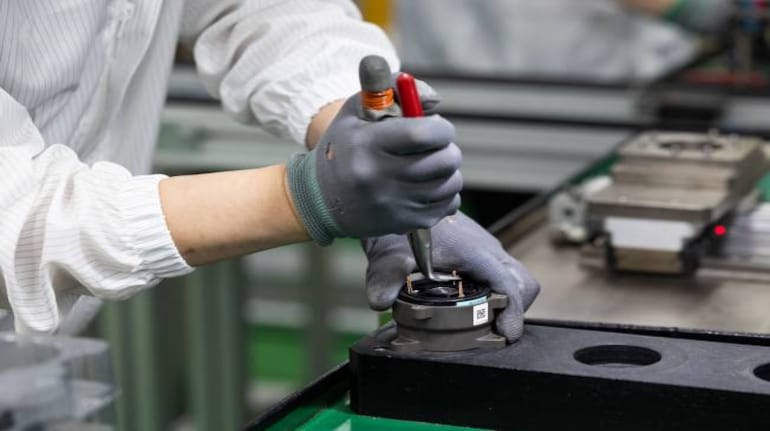



The situation around Taiwan remained tense as China continued its war games to protest US House speaker Nancy Pelosi’s visit to Taiwan earlier in the week.
Though the coercive military exercises with warships, fighter jets, and live-fire drills that involved lobbing ballistic missiles over Taiwan ended on Sunday, the military exercise in the Yellow Sea that began on Saturday will continue till August 15.
The People’s Liberation Army has been conducting a number of live-fire exercises this month in the wake of Pelosi’s visit to Taiwan.
The strong Chinese reaction is also being seen as part of the 'high-tech' war in the ongoing Sino-American tussle over global tech leadership.
Taiwan is the leading chip maker in the world and dominates the global semi-conductor market. The island’s autonomy is of vital geopolitical interest to the US which, like China, is dependent on Taiwan for high-tech chips.
China has been developing its own semi-conductor industry. However, it is still dependent on Taiwan for both high-end and basic chips.
Chips are the brains of electronic devices. They are used in smartphones, laptops, data centres, and sophisticated weapons systems like the Javelin anti-tank missiles that the US has supplied to Ukraine.
China’s strong reaction to Pelosi’s visit comes on the back of serious US efforts to cut-off China’s access to high-end Taiwanese chips.
China considers Taiwan part of its territory and its reunification with the mainland has become exceedingly important for premier Xi Jinping, who is seeking a record third-term in power at the forthcoming National Congress of the Chinese Communist Party (CCP) in November.
Beijing has been extremely sensitive to any high-level visit to Taiwan, especially from the US.
The US is heavily dependent on Taiwan, especially its leading company — the Taiwan Semiconductor Manufacturing Co. (TSMC) — for cutting-edge chips.
In recent months, the US has been trying to convince Taiwan’s leading chip producers, like TSMC, to shift production to the US and Japan in order to reduce their vulnerability to Chinese attacks.
TSMC alone controls over 53 percent of the market, and along with other Taiwanese chip producers, supplies more than 63 percent of the world’s chips.
The company’s decision to move some of its production to the US and Japan was seen by Beijing as America’s attempt to cut off China’s access to semi-conductors, and scuttle its emergence as a modern economy.
During her trip to Taiwan, Pelosi met TSMC chairman Mark Lui regarding operations in the US and ceasing supply of cutting-edge chips to China.
The Chips and Science Act passed recently by both houses of US Congress, has sanctioned $280 billion for scientific research in areas like artificial intelligence and quantum computing, including $52 billion to encourage chipmakers and to prop up the US semiconductor industry.
Though the presence of Taiwanese chipmakers in China was always a concern for Washington, since the advent of 5G technology, the high-tech war between the US and China has intensified further.
The US has asked companies that accept federal subsidies not to materially expand their chipmaking capacity in China or other countries of concern for 10 years.
American policy makers see the Act as an essential part of competition with China, both economically and in terms of national security.
Since 1990, United States’ share of semi-conductor manufacturing has fallen from 37 percent to 12 percent. Nearly 75 percent of the world’s overall capacity is now in Asia.
Many global chip majors produce their chips in China. TSMC has a plant in Nanjing that makes 16 nm (nanometre) and 28 nm chips. Other leading companies like Samsung, SK Hynix, Intel and Micron also have a strong presence in China. But few major chipmakers produce their most cutting-edge products in China.
The Chips+ Act, as the legislation is known, has a provision for chip-making firms to continue investing in China to protect existing and significant business interests in the country. But it applies only to the manufacture of `legacy semi-conductors’, which include 28-nm or older-generation chip technology. For semi-conductors, the smaller the nm, the more advanced the chip.
Beijing is concerned with the growing trend in US policy that started with former president Barack Obama’s Asia pivot (away from the mid-east), continued under Donald Trump (trade tariffs and the Quad), and still abides with president Joe Biden’s Indo-Pacific Economic Framework, that encourages Asian countries to move their operations out of China.
But the degree of decoupling between the US and China has been minimal. In 2021, US trade with China increased 20 percent from pre-Covid levels to reach $670 billion. China also continues to be Taiwan’s largest trade partner and the island’s trade with the mainland was over $188 bn in 2021.
Many chipmakers have welcomed the Chips Act. Firms like TSMC, Samsung, SK Hynix, as well as Intel and Micron, have all announced their decision to develop their US operations.
But experts argue that rebuilding the semi-conductor ecosystem is not only expensive but also involves huge supply chain networks for the supply of a number of chemicals and materials, chip-making equipment, and other consumable parts.
China plans to meet 70 percent of its chip requirements through domestic manufacture in the next three years. That is a tall order. Taller still is being able to compete with brands like TSMC and Samsung.
As the high-tech war between the US and China heats up, America will continue to find ways to draw Taiwan away from China.
Discover the latest Business News, Sensex, and Nifty updates. Obtain Personal Finance insights, tax queries, and expert opinions on Moneycontrol or download the Moneycontrol App to stay updated!